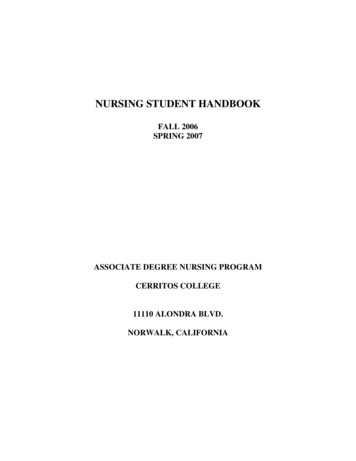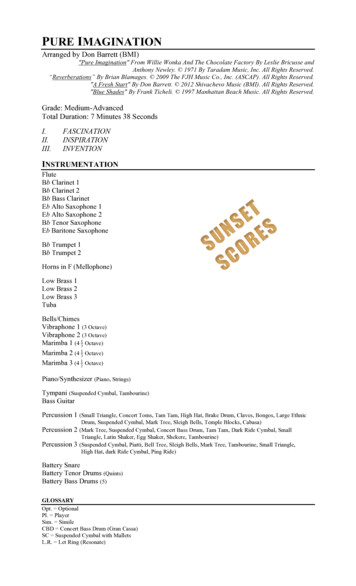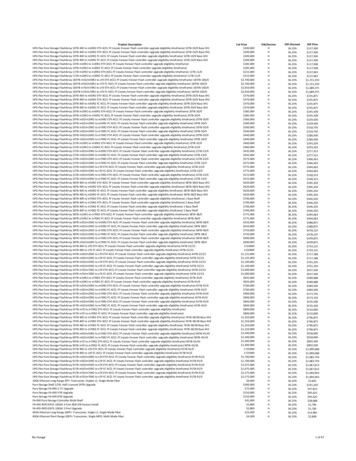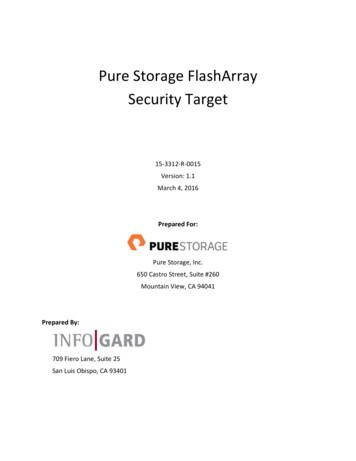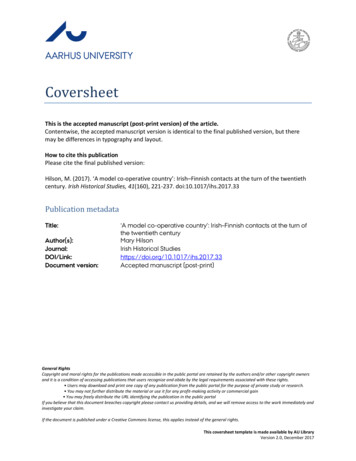
Transcription
CoversheetThis is the accepted manuscript (post-print version) of the article.Contentwise, the accepted manuscript version is identical to the final published version, but theremay be differences in typography and layout.How to cite this publicationPlease cite the final published version:Hilson, M. (2017). ‘A model co-operative country’: Irish–Finnish contacts at the turn of the twentiethcentury. Irish Historical Studies, 41(160), 221-237. doi:10.1017/ihs.2017.33Publication metadataTitle:Author(s):Journal:DOI/Link:Document version:‘A model co-operative country’: Irish–Finnish contacts at the turn ofthe twentieth centuryMary HilsonIrish Historical Studieshttps://doi.org/10.1017/ihs.2017.33Accepted manuscript (post-print)General RightsCopyright and moral rights for the publications made accessible in the public portal are retained by the authors and/or other copyright ownersand it is a condition of accessing publications that users recognize and abide by the legal requirements associated with these rights. Users may download and print one copy of any publication from the public portal for the purpose of private study or research. You may not further distribute the material or use it for any profit-making activity or commercial gain You may freely distribute the URL identifying the publication in the public portalIf you believe that this document breaches copyright please contact us providing details, and we will remove access to the work immediately andinvestigate your claim.If the document is published under a Creative Commons license, this applies instead of the general rights.This coversheet template is made available by AU LibraryVersion 2.0, December 2017
1Mary Hilson, ‘“A model co-operative country”: Irish-Finnish contacts at the turn of thetwentieth century’, Irish Historical Studies, 41, 160 (2017), pp. 221-237. DOI:10.1017/ihs.2017.33‘A model co-operative country’: Irish-Finnish contacts at the turn of the twentiethcenturyMary Hilson*Aarhus University, DenmarkAbstract: Agricultural co-operative societies were widely discussed across latenineteenth-century Europe as a potential solution to the problems of agriculturaldepression, land reform and rural poverty. In Finland, the agronomist Hannes Gebharddrew inspiration from examples across Europe in founding the Pellervo Society, topromote rural cooperation, in 1899. He noted that Ireland’s ‘tragic history’, itsstruggle for national self-determination and the introduction of co-operative dairies totackle rural poverty, seemed to offer a useful example for Finnish reformers. Thisarticle explores the exchanges between Irish and Finnish co-operators around the turnof the century, and examines the ways in which the parallels between the two countrieswere constructed and presented by those involved in these exchanges. I will alsoconsider the reasons for the divergence in the development of cooperation, so that evenbefore the First World War it was Finland, not Ireland, that had begun to be regardedas ‘a model co-operative country’.
2Agricultural co-operative societies were widely discussed across late nineteenth-centuryEurope as a potential solution to the problems of agricultural depression, land reformand rural poverty.1 Rural cooperation could take many forms. It included co-operativecreameries2 and slaughterhouses for processing agricultural goods; national federationsto market, standardise and export goods such as butter and bacon; purchasing societiesto supply farmers with necessities such as fertiliser and animal feed; credit unions andrural banks. Notably in Denmark and Finland, some consumer co-operative societies forthe supply of groceries and household essentials were also considered part of the wider* Department of History & Classical Studies, School of Culture and Society, Aarhus University,Denmark, mary.hilson@cas.au.dk. This article draws on research carried out as part of a largerresearch project on the history of the co-operative movements in the Nordic countries, begunduring a period as a visiting researcher at the Centre for Nordic Studies, Helsinki University,supported by the Nordic Centre of Excellence NordWel. The present article arose out ofcollaborative work with Pirjo Markkola and Ann-Catrin Östman. Thanks also to JohannaRainio-Niemi, Andrew Newby and the anonymous referees of Irish Historical Studies for theirhelpful comments.1Mary Hilson, Pirjo Markkola and Ann-Catrin Östman, ‘Introduction: co-operatives and thesocial question’, in eaedem (eds), Co-operatives and the social Question: the co-operativemovement in northern and eastern Europe (1880-1950) (Cardiff, 2012), pp 1-24; see also theother chapters in the same volume.2Co-operative creameries or dairies (Finnish: osuusmeijeri; Swedish: andelsmejeri) collectedmilk from their farmer members for processing into products such as butter. In Ireland theywere always known as creameries. To avoid confusion, the latter term is used throughout thearticle. (Thanks to an anonymous referee for alerting me to this point).
3agricultural co-operative movement.3 For their supporters, co-operative societies servedabove all an economic function, providing small farmers with the means to avoid debt,raise capital, adopt technological innovations and adapt their production to the needs ofinternational markets. Co-operatives thus provided a potential solution to the problemsfaced by small peasant proprietors in conjunction with, or in the wake of, land reform.4Frequently, however, cooperation was also ascribed a moral purpose. Self-help andeducation would encourage European peasants to resist the temptation to emigrate or toespouse radical ideologies, and ensure that they would instead take their rightful placeas the backbone of the modern nation state. Agricultural co-operatives thus played animportant role in the nationalist mobilisations of the early-twentieth century.5This article takes the example of the agrarian co-operative movement to examinesome comparative and transnational dimensions of debates about agriculturaldevelopment and rural mobilisation in Finland and Ireland in the late-nineteenth andearly-twentieth centuries. In both countries, agricultural cooperation is understood tohave emerged in response to the post-depression agricultural crisis and the developmentof a commercial agricultural sector aimed primarily at the export market. Cooperation3Mary Hilson, ‘The Nordic consumer co-operative movements in international perspective,1890-1939’ in Risto Alapuro and Henrik Stenius (eds), Nordic associations in a Europeanperspective (Baden-Baden, 2010), p. 229.4Anu Mai Kõll, ‘Cooperatives as part of the national movement in the Baltic countries’ inTorsten Lorenz (ed.), Cooperatives in ethnic conflicts: eastern Europe in the 19th and early 20thcentury (Berlin, 2006), pp 45-58.5Torsten Lorenz, ‘Introduction: cooperatives in ethnic conflicts’ in Lorenz (ed.), Cooperativesin ethnic conflicts, pp 9-44.
4was discussed in the context of wider debates about land reform and the ‘socialquestion’, especially as it affected tenant farmers and peasant proprietors. Like ineastern Europe, its development also has to be seen in relation to wider politicalmovements in the years before independence.6These similarities are not surprising, for Ireland was frequently referred to byFinnish co-operative reformers and the Finnish co-operative organisation Pellervo(founded 1899) was partly modelled on the Irish Agricultural Organisation Society(I.A.O.S., founded 1894). There were a number of at least superficial similaritiesbetween Finland and Ireland in the years before the First World War.7 Both were theperipheral, subject territories of large empires, a status that was being challenged byvigorous nationalist movements by the end of the nineteenth century.8 Both were,moreover, largely rural societies dominated by agriculture. The late nineteenth-century‘social question’, in each case, was not so much about sprawling cities and industrialworkers as it was about the welfare and social integration of the rural population,especially small tenant farmers.9 Still in living memory, of course, were the terriblesubsistence crises of the 1840s in Ireland and the 1860s in Finland.10 But debates about6Hilson, Markkola and Östman, ‘Introduction’, pp 8-11.7For more on the similarities and contrasts in the Irish and Finnish experiences, see theintroduction to this collection by Mc Mahon and Newby.8Bill Kissane, ‘Nineteenth-century nationalism in Finland and Ireland: a comparative analysis’in Nationalism and Ethnic Politics, vi, no. 2 (2000), p. 25.9Hilson, Markkola and Östman, ‘Introduction’, pp 1-24.10For a comparative account, see Andrew G. Newby, ‘“Acting in their appropriate and wantedsphere”: the Society of Friends and Famine in Ireland and Finland, c. 1845-68’ in Patrick
5the social question were also shaped by two continuing processes of change: firstly, theneed for farmers to adapt to a new economic climate following the internationalagricultural depression of the 1870s; and, secondly, political debates about the landquestion, which in Ireland had been partially resolved by the 1880s but in Finland wereto come to a head after the turn of the twentieth century.11The first part of the article considers the significance of transnational links andtransfers for the early development of cooperation in Finland, with particular referenceto the Irish case as a model. It asks how international models were used, how cooperative ideas were imported and how they were transformed in national contexts. Inthe second part of the article, I review the possible reasons for the divergence of theIrish and Finnish co-operative movements and the different roles they play in theirrespective national historiographies, and consider what these two cases may tell usabout why co-operative societies flourish or fail more generally. The Irish co-operativemovement has been compared with that of other European countries includingFitzgerald, Christine Kinealy and Gerard Moran (eds), Irish hunger and migration: myth,memory and memorialization (Quinnipiac, 2015), pp 107-20, 190.11On land conflicts in early twentieth-century Finland, see Sami Suodenjoki, ‘Land agitationand the rise of agrarian socialism in south-western Finland, 1899-1907’ in Mary Hilson, SilkeNeunsinger and Iben Vyff (eds), Labour, unions and politics under the north star: the Nordiccountries, 1700-2000 (New York, 2017). See also Sami Suodenjoki’s contribution to thiscollection.
6Denmark, the Netherlands and France but there are no direct comparisons with Finland,despite the existence of the contacts mentioned above.12The sources for the article include the foreign correspondence of the PellervoSociety, some of which is also included in the personal correspondence of its founder,Hannes Gebhard, at the National Archives of Finland in Helsinki. This has beensupplemented with material from contemporary published sources, including cooperative journals, newspapers, books and pamphlets. The focus on the Finnish sourcesreflects the strength of the Irish influence on the Finnish movement, at least during itsearly years. For Ireland, I have relied more heavily on secondary sources, includingPatrick Doyle’s doctoral thesis on the I.A.O.S., which was especially helpful.I12Timothy W. Guinnane, ‘A failed institutional transplant: Raiffeisen’s credit co-operatives inIreland, 1894-1914’ in Explorations in Economic History, xxxi, no. 1 (1994), pp 28-61; CarlaKing, ‘The early development of agricultural co-operation: some French and Irish comparisons’in Proc. R.I.A., sect. c, xcvi, no. 3 (1996), pp 67-86; Kevin H. O’Rourke, ‘Culture, conflict andco-operation: Irish dairying before the Great War’ in The Economic Journal, cxvii, no. 523(2007), pp 1357-79; Christopher L. Colvin and Eoin McLaughlin, ‘Raiffeisenism abroad: whydid German co-operative banking fail in Ireland but prosper in the Netherlands?’ EconomicHistory Review, lxvii, no. 2 (2013), pp 1-25.
7The roots of co-operation were diverse and multi-centred.13 The system of consumercooperation attributed to the Rochdale Pioneers came to be widely known and cited, butagricultural cooperation had a different genealogy. Co-operative credit societies werestrongly influenced by German examples, while from the 1880s the agriculturalproduction societies – especially creameries and slaughterhouses – organised inDenmark came to attract international attention.14 These societies shared with consumerco-operatives the principles of democratic member control and mechanisms fordistributing the surplus in proportion to patronage, but they also differed in importantrespects, for example in their willingness to rely on state funds to assist start up.15Besides the material benefits of providing access to capital, technological innovation,marketing and quality control, co-operatives were perceived to have a moral purpose.They would educate their members not only in the latest agricultural techniques but alsoin the practicalities of business management; they would tackle the widespread problemof usury and contribute to developing self-confidence, trust and sociability within ruralcommunities.13Mary Hilson, ‘Transnational networks in the development of the co-operative movement inthe early twentieth century: Finland in the Nordic context’ in Hilson, Markkola and Östman(eds), Co-operatives and the Social Question, p. 87.14Johnston Birchall, The international co-operative movement (Manchester, 1997), pp 11, 14.15The question of state assistance was to be the source of a schism in the International Co-operative Alliance in 1902, leading to the secession of the German union of agricultural cooperatives. See Rita Rhodes, The International Co-operative Alliance during war and peace,1910-1950 (London, 1995), p. 26.
8As Pauli Kettunen has noted, international comparisons were extremelyimportant for the construction of national politics in the late-nineteenth centu
Users may download and print one copy of any publication from the public portal for the purpose of private study or research. You may not further distribute the material or use it for any profit-making activity or commercial gain You may freely distribute the URL identifying the publication in the public portal If you believe that this document breaches copyright please contact us .

